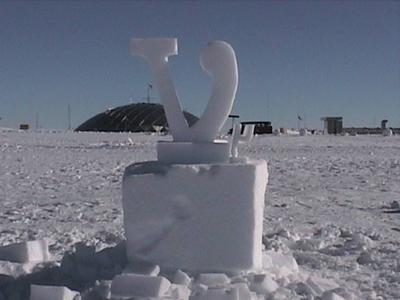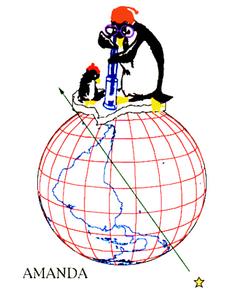14 December, 2002
14 December, 2002
What happened today ?
a) ride in a PistenBully 20 km out from the station to collect snow
samples : Movie on drachen website, more on that in tomorrow¸s
journal.
b) Digging out AMANDA cables, heavily drifted over. Movie on drachen
website, more on that in tomorrow's journal as well.
c) made new fake AMANDA website that was very funny, and gave me
giggles (lack of sleep) all afternoon.
But today, let's talk about neutrinos.
Cosmic Gall by John Updike
Neutrinos, they are very small
They have no charge and have no mass
And do not interact at all
The Earth is just a silly ball
To them, through which they simply pass,
Like dustmaids down a drafty hall,
Or photons through a sheet of glass.
A delightful poem, much embraced by physicists, who like everyone,
are happy to have anyone show an interest in what they care about.
But it's inaccurate in a number of ways, though Updike probably had
it right at the time he wrote it. But a lot's changed in neutrinos
recently, so much so that the Nobel prizes in Physics this year were
awarded for two physics experiments which detected a neutrino signal
from a supernova in 1987. Those results gave impetus to the
construction of the many modern neutrino detectors around the world :
AMANDA, ANTARES, Super-K, SNO, and others.
What did Updike get wrong ?
a) Neutrinos now do appear to have mass. This is a recent conclusion,
based on the observation that the 3 types of neutrinos (electron,
muon, and tau) oscillate between one type and another. For a quantum
physicist, this "morphing" can only occur among parcticles with mass.
Neutrino mass oscillation theory has helped explain a conundrum in
physics.
For 50 years, the physics of the sun and other stars has been worked
out in great detail. The sun makes lots of electron neutrinos as it
fuses hydrogen to helium. The exact flux of neutrinos reaching the
earth was precisely predicted by fusion theory, yet the actual
measured flux of electron neutrinos is far less than predicted. Where
are the missing neutrinos ?
It now looks as if many electron neutrinos change to muon neutrinos
on their way to the earth, and muon neutrinos were not detected by
earlier experiments. But 2 underground experiments, both large water
tanks surrounded by PMTs in deep mines, can detect muon neutrinos,
which arrive at the earth in greater numbers than fusion theory would
suggest. OK, then. Too few electron neutrinos, too many muon
neutrinos'.They change from one kind to another enroute from Sun to
Earth.
Experiments are now underway in Japan & the United States to
manufacture a precisely characterized neutrino beam, send it several
hundred kilometers through the earth to a detector, and measure the
relative proportions of arriving neutrino types. This will allow
physicists to better understand the oscillation process, and set some
limits on neutrino mass.
How much of the universe's mass belongs to neutrinos ? Does the mass
of neutrinos account for the so-called dark matter that seems to be
invisible but binds galaxies together through the force of gravity?
We'll certainly have a better idea in 10 years.
b) Neutrinos do interact, with ordinary matter, but just barely. In
physics, we say that neutrinos have a very small cross-section, a
very low probability of "hitting" something. Hitting isn't even a
very good word, because when you start to talk about very small
things, they don't hit, they don't touch, they just "interact".
Neutrinos are manufactured in certain types of nuclear reactions
involving the so-called nuclear "weak force." They are electrically
neutral, as Updike correctly says, which means they¸re not subject to
the electromagnetic force which makes protons and electrons attract.
And they¸re not subject to the strong nuclear force, which holds the
nuclei of atoms together. If they do indeed have mass, then they¸re
pulled by gravity. So out of the 4 FUNDAMENTAL FORCES, neutrinos are
only involved in 2, the two weakest.
That makes them ideal messengers from distant objects in the
universe, because they come more or less straight to us, unaffected
very much by what's around them. It also makes them hard to detect at
all. That's why you need a BIG detector.
c) Photons, "parcticles" of light, do pass through glass. But not
unaffected. They slow down as they pass through (that's an
oversimplification, but this is complicated enough already). That's
why light bends as it passes through glass, if it strikes the surface
at an angle. This is called refraction, and I for one am ha

The symbol for the neutrino, carved in ice at the South Pole.

The AMANDA logo. AMANDA is interested in detecting parcticles which come into the detector from BELOW. These can only be neutrinos, as they're the only parcticles that would penetrate the entire Earth. The ice tank detector that Bai & I have been working on is a prototype detector for ICETOP. Nearly 200 of these tanks will sit on the surface of the snow above the ICECUBE array in the deep ice. ICETOP will collect information about all the parcticles coming from the air above ICECUBE. They're (mostly) not neutrinos, so ICETOP information will be subtracted from the events recorded by ICECUBE, leaving only neutrino events.
Contact the TEA in the field at
.
If you cannot connect through your browser, copy the
TEA's e-mail address in the "To:" line of
your favorite e-mail package.
|
